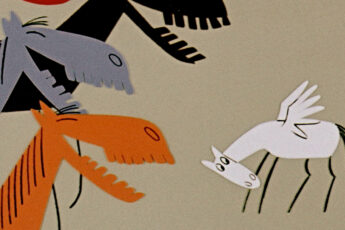Arrogance of the Talented
Miklós Jancsó’s Wake Up, Mate, Don’t You Sleep (Kelj fel, komám, ne aludjál!, 2002)
Vol. 26 (February 2013) by Konstanty Kuzma
Last fall, I went to a concert Herbie Hancock gave in Rome. The concert was titled Plugged In/A Night of Solo Explorations, and took place north of the city centre near the Stadio Flaminio, the former National Rugby stadium. Though located rather impractically and cars being forced to park on all parts of the side walk, the voluminous auditorium was jam-packed with a young-old audience. Of course, this is hardly surprising: Herbie Hancock is an institution. Like most of the current jazz elite, he was discovered early by Miles Davis, joining the Second Great Quintet in 1963 (which, from 1964, would also consist of Ron Carter, Tony Williams and Wayne Shorter), a fortunate encounter followed by an enviable solo career. Hancock is a Grammy winner, but his success may best be measured by the universal popularity of such songs as Cantaloupe Island, Watermelon Man, Chameleon or Rockit. In Rome, Hancock performed two of the latter four during his encore, but the standing ovation demanding it was downright undeserved.
After commencing with two mediocre solo pieces (these skillfully dissonant, but kitschy compositions were surely the best part of the evening), Hancock said he wanted to “experiment.” That one is so keen on pointing this out at a jazz concert (after all, the title already says “Solo Explorations”) raises one’s suspicion. Still, what followed would have exceeded the expectations of the greatest skeptics. With one piano, three keyboards, four iPads and an iMac mounted on stage (Apple must love Herbie), Hancock started creating 5 to 10 second rhythmic and melodic loops and putting chords and solos on top of that – sometimes as additional layers that would also start looping, at other times as regular harmonic lines. In musical jargon, this is a form of an activity generally known as jamming, or improvisation. In one way or another, improvisation is of course constitutive of jazz, but this form is more extreme because it doesn’t manipulate melodies, themes or songs, but attempts to construct an entire harmonic foundation from scratch.
The result was violently mediocre. Moving around from device to device, Hancock seemed to search for a power that wasn’t there that night. The melodic layers that kept accumulating weren’t harmonically incompatible, but neither did they join together to create a recognizable structure. Sequence after sequence, one was drawn back to the same bass line, unperturbed by the constant solos that had no beginning or end. The live compositions were aimless, like uniform background music that is only tolerable if you do not listen to it attentively. Of course, Hancock and many of his fellow musicians can create a whole lot of things from scratch – otherwise, music wouldn’t exist. But it constitutes a special degree of arrogance to think that you can create qualitative music on your own at the push of a button – indeed, even if you’re Herbie Hancock.
It could be said that Hungarian director Miklós Jancsó is to Eastern European cinema what Herbie Hancock is to jazz music. Jancsó’s films reflect the best that Eastern European films had to offer in the 1960s and onward: a political and social dimension, superb cinematography and acting, and a unique directorial trademark. Similarly to Hancock, his success reflects both in awards (he has received Lifetime Achievement Awards in both Cannes and Venice) and the critical canon, but unfortunately, they also seem to connect in a less desirable respect, namely an explicit degree of artistic arrogance.
In 2002, Jancsó made Wake Up, Mate, Don’t You Sleep, en episodic comedy revolving around two men who are initially introduced as Jews awaiting execution during WW2, but soon change identity as the temporal setting of the film shifts between different historical periods (the periods represented are WW2, Hungary’s Communist past, and the present). The “prisoners,“ as the two refer to themselves throughout the temporal movement – a typically unimaginative political allegory -, are gradually introduced to various colorful characters (including a poorly acting Jancsó appearing as himself) with whom they share pseudo-philosophical and pseudo-political conversations. This, it doesn’t take long to realize – plus musical interludes, in which Hungarian rock songs are performed by characters on the screen –, is the final product of a whole lot of improvisation. The principal duo hardly performs a coherent dialogue, with most of the noticeably vulgar exchanges containing at least one of these three magic sentences: “we are prisoners,” “are you crazy?”, “shut up”.
But what is most frightening about this film is Jancsó’s awareness of both these patterns and the film’s dramatic aimlessness. The principal duo explicitly refers to the fact that there’s no script and to the constant swearing on screen (the latter’s a commonly observed by-product of improvisation), and, towards the end, prompts Jancsó to finally say something concrete. When Jancsó comforts the request by saying that “films, like dreams, are real“ and that “life’s a heart and a knife under a sky,” Jancsó (still acting as himself) agrees that this is flat. Is Jancsó admitting, then, that his film is flat, that it is full of meaningless symbols, and that it lacks a dramatic backbone, as the characters keep repeating? No. The ultimate proof of his hypocrisy comes in the very last scene, when a character from the film vividly describes how she was abused by Nazis during the Second World War. Here, the otherwise fully obscured line between irony and literal speech is finally visible: with the camera latching onto the girl’s face (which doesn’t conceal the fact that she’s on the verge of crying), we understand that Jancsó is trying to touch us. But it is justified to ask whether minute 76 (and less than 3 to go) is the right moment to start being meaningful.
Jancsó seems to treat the reference to problems in his film as a justificatory strategy: by anticipating potential objections of viewers, these flaws get the air of being well-grounded, and hence no flaws at all. Hancock did something very similar in Rome when he welcomed his audience by saying how odd it was that he had so many devices with him on stage: “Do I really need all of these?” Of course he didn’t, but rather than having to face criticism, Hancock preferred to give his audience the impression of being self-critical.
There exists a false consensus among certain artists that by referring to flaws in one’s own work explicitly, they can be nullified. But in fact it is all the more troubling to find an artist making mistakes he is well aware of.




Leave a Comment